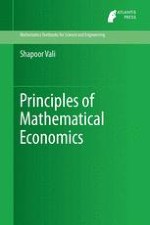2014 | OriginalPaper | Buchkapitel
4. Market Equilibrium Model
verfasst von : Shapoor Vali
Erschienen in: Principles of Mathematical Economics
Verlag: Atlantis Press
Aktivieren Sie unsere intelligente Suche, um passende Fachinhalte oder Patente zu finden.
Wählen Sie Textabschnitte aus um mit Künstlicher Intelligenz passenden Patente zu finden. powered by
Markieren Sie Textabschnitte, um KI-gestützt weitere passende Inhalte zu finden. powered by
